Seed
Animal Resources Available
Pig
A) Indigenous Pig of Meghalaya
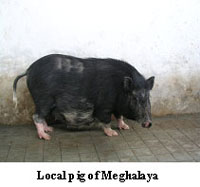 Also known as Khasi local pigs. Livestock production Division is maintaining the parent stock of indigenous pigs. They are used for crossbreeding with exotic breeds like Hampshire to produce crossbred pigs. Khasi local pigs are characterized by poor growth rate, poor feed conversion efficiency, small body size at maturity and small litter size at birth. However, they are better adopted to local climatic conditions. The age of maturity is early in local pigs. They can be maintained on kitchen wastes, vegetables and grasses.
Also known as Khasi local pigs. Livestock production Division is maintaining the parent stock of indigenous pigs. They are used for crossbreeding with exotic breeds like Hampshire to produce crossbred pigs. Khasi local pigs are characterized by poor growth rate, poor feed conversion efficiency, small body size at maturity and small litter size at birth. However, they are better adopted to local climatic conditions. The age of maturity is early in local pigs. They can be maintained on kitchen wastes, vegetables and grasses.
B) Hampshire
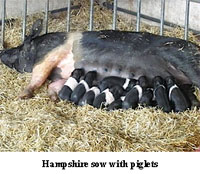 Hampshire pig is a domestic swine breed characterized by erect ears and a black body with a whitish band around the middle, covering the front legs. Hampshire pigs are noted for being well-muscled and rapid growers, and for exhibiting good carcass quality when used as meat animals. When used as breeding stock, the sows of this breed have been praised for their capacity as mothers, having "extra longevity in the sow". Hampshire are good tempered; they do not grow as fast as many cross-breds, but they do grow faster than Yorkshire.
Hampshire pig is a domestic swine breed characterized by erect ears and a black body with a whitish band around the middle, covering the front legs. Hampshire pigs are noted for being well-muscled and rapid growers, and for exhibiting good carcass quality when used as meat animals. When used as breeding stock, the sows of this breed have been praised for their capacity as mothers, having "extra longevity in the sow". Hampshire are good tempered; they do not grow as fast as many cross-breds, but they do grow faster than Yorkshire.
C) Duroc
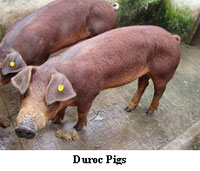 The Duroc is a large-framed, late-maturing type, excellent for heavy-carcase production. The forequarters, particularly the head and neck, are light and it has small lop ears. The skin is a solid reddish colour, varying from gold to a deep, brick red. They have a medium length and slight dish of the face. The Duroc pig were originated from USA, and today is commonly found as a terminal sire in modern crossbreeding production systems. It is a muscular breed with a distinctive red coat and drooped ears. Duroc boars are often called 'terminal sires' in the crossbreeding operations. Although the purebred sows have lower fertility compared to other commercial breeds, their crossbred offspring have adequate fertility, and because of their coloured skin they have been used in organic and free range enterprises, as they are less prone to heat stress. In Winter they produce a thick coat, which is shed in Summer, so they are capable of withstanding a range of temperatures. Sows have very good mothering ability. They remain fairly lean as they grow, not putting down excess fat. The result is succulent meat with a nice level of fat within it.
The Duroc is a large-framed, late-maturing type, excellent for heavy-carcase production. The forequarters, particularly the head and neck, are light and it has small lop ears. The skin is a solid reddish colour, varying from gold to a deep, brick red. They have a medium length and slight dish of the face. The Duroc pig were originated from USA, and today is commonly found as a terminal sire in modern crossbreeding production systems. It is a muscular breed with a distinctive red coat and drooped ears. Duroc boars are often called 'terminal sires' in the crossbreeding operations. Although the purebred sows have lower fertility compared to other commercial breeds, their crossbred offspring have adequate fertility, and because of their coloured skin they have been used in organic and free range enterprises, as they are less prone to heat stress. In Winter they produce a thick coat, which is shed in Summer, so they are capable of withstanding a range of temperatures. Sows have very good mothering ability. They remain fairly lean as they grow, not putting down excess fat. The result is succulent meat with a nice level of fat within it.
D) Ghungroo (GR)
Ghungroo is a native pig breed which is mainly reared by the tribes of Duars’Valley and allied zone. Ghungroo breed of pig are known for high prolificacy and faster growth rate.t is most prevalent in Duars’ valley of eastern Sub-Himalayan region of West Bengal between 880 to 900 E longitudes and 26.30 to 27.30 N latitude. The area belongs to the civil districts of Darjeeling, Jalpaiguri and Northern part of Cochbehar. The breed is also available in the eastern part of Nepal adjoining Darjeeling district. Average litter size at birth is 11.92±0.06 and litter size up to eighteen is common. Body weight at birth, 5 months and 1 year of age are 1.08±0.22, 38.91±1.49 and 106.3±0.31 kg respectively irrespective of sex. This breed reaches puberty at 7-9 months of age. Most characteristic feature of Ghungroo pig is its bull dog appearance and wrinkled skin which make them resilient to high temperature and humidity stress.
E) Crossbred pigs
Division of Livestock Production has developed the upgraded variety of pigs by crossing the local pigs of Meghalaya with exotic Hampshire breed. Upgrded pig varieties (with 50, 75 and 87.5% exotic inheritance) are performing better in terms of body weight gain, feed conversion efficiency, carcass characteristic, litter size at birth and weaning, litter weight at birth and weaning etc. They may attain the body weight of 100 to 150 kg in one year under optimum feeding and managemental conditions.
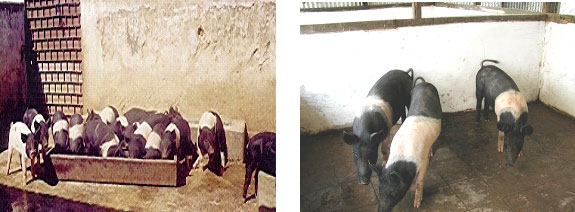 |
Goat
 Goat is one of the world’s smallest domesticated livestock. Goats can survive on bushes, trees, desert scrub, and vegetation that sheep and cattle are not able to consume. This dietary versatility and adaptability combined with a hardy constitution makes goats a primary livestock animal for most of the world. The goat, “poor man’s cow” is multipurpose animal to provide milk meat, hide, hair (fur) and manure for soil. Goats can reproduce under extreme conditions that would eliminate other species. They can live in hot, tropical climates as well as cool, temperate climates. They seem to be able to live and even flourish under desert conditions. These factors have made goats a very important domestic animal. Goat farming can be a profitable occupation of a farmer and can be fit well into mixed farming The goat is a multipurpose animal producing meat, milk, hide, fiber and manure. Goats have very few demands of housing and management. They hardly need separate housing and happily share their homes with their owners or his other livestock. Goats can be raised by landless agricultural labourers, ladies and children because they can thrive well on variety of leaves, shrubs, bushes, kitchen waste etc. Goats are cheaper to maintain, easily available and have a friendly disposition. Goats are capable of adapting to various agro climatic conditions ranging from arid dry to cold arid to hot humid. They can be raised in plains, hilly tracts, sandy zones and at high altitudes. Goats are more tolerant to hot climate than other farm animals. Goats suffer from fewer ailments than other large animals. Milk is cheap, wholesome, easily digestible and nutritious. Goat milk is finer than cow milk i.e. the fats and proteins are present in a finer state and are more easily digestible, especially by children and invalids. • Goat milk has lesser allergic problems than other species of livestock. Goat milk is used as ayurvedic medicine for personas ailing with asthma, cough, diabetes etc. And has higher buffering qualities and this enhances its value for patients suffering from peptic ulcers, liver dysfunction, jaundice, billiard disorders and other digestive problems.Goat hide is used for the manufacture of leather products. Goat hairs are used for the manufacture of rugs and ropes. Pashmina shawls, Mohair and Kashmere carpets are in great demand and are sold at very high prices. • Goat manure is 2.5 times richer in nitrogen and phosphoric acid than cow manure. Goat rearing is the backbone of economy of small and landless farmers in India. It is an insurance against crop failure and provides alternate source of livelihood to farmers all the year round. Goats play an important role in income generation, capital storage, employment generation and improving household nutrition. Goats are among the main meat-producing animals in India, whose meat (chevon) is one of the choicest meats and has huge domestic demand. Besides meat, goats provide other products like milk, skin, fibre and manure. Goats are important part of rural economy, particularly in the arid, semi arid and mountainous regions of the country with more than 124 million population.
Goat is one of the world’s smallest domesticated livestock. Goats can survive on bushes, trees, desert scrub, and vegetation that sheep and cattle are not able to consume. This dietary versatility and adaptability combined with a hardy constitution makes goats a primary livestock animal for most of the world. The goat, “poor man’s cow” is multipurpose animal to provide milk meat, hide, hair (fur) and manure for soil. Goats can reproduce under extreme conditions that would eliminate other species. They can live in hot, tropical climates as well as cool, temperate climates. They seem to be able to live and even flourish under desert conditions. These factors have made goats a very important domestic animal. Goat farming can be a profitable occupation of a farmer and can be fit well into mixed farming The goat is a multipurpose animal producing meat, milk, hide, fiber and manure. Goats have very few demands of housing and management. They hardly need separate housing and happily share their homes with their owners or his other livestock. Goats can be raised by landless agricultural labourers, ladies and children because they can thrive well on variety of leaves, shrubs, bushes, kitchen waste etc. Goats are cheaper to maintain, easily available and have a friendly disposition. Goats are capable of adapting to various agro climatic conditions ranging from arid dry to cold arid to hot humid. They can be raised in plains, hilly tracts, sandy zones and at high altitudes. Goats are more tolerant to hot climate than other farm animals. Goats suffer from fewer ailments than other large animals. Milk is cheap, wholesome, easily digestible and nutritious. Goat milk is finer than cow milk i.e. the fats and proteins are present in a finer state and are more easily digestible, especially by children and invalids. • Goat milk has lesser allergic problems than other species of livestock. Goat milk is used as ayurvedic medicine for personas ailing with asthma, cough, diabetes etc. And has higher buffering qualities and this enhances its value for patients suffering from peptic ulcers, liver dysfunction, jaundice, billiard disorders and other digestive problems.Goat hide is used for the manufacture of leather products. Goat hairs are used for the manufacture of rugs and ropes. Pashmina shawls, Mohair and Kashmere carpets are in great demand and are sold at very high prices. • Goat manure is 2.5 times richer in nitrogen and phosphoric acid than cow manure. Goat rearing is the backbone of economy of small and landless farmers in India. It is an insurance against crop failure and provides alternate source of livelihood to farmers all the year round. Goats play an important role in income generation, capital storage, employment generation and improving household nutrition. Goats are among the main meat-producing animals in India, whose meat (chevon) is one of the choicest meats and has huge domestic demand. Besides meat, goats provide other products like milk, skin, fibre and manure. Goats are important part of rural economy, particularly in the arid, semi arid and mountainous regions of the country with more than 124 million population.
Assam Hill Goat: Livestock production Division is maintaining Assam Hill goat. This breed is found in Assam and its adjoining areas. The body coat is black and sometimes white and the breed is famous for meat production. It is a poor milk yielder. Selected animals of this breed maybe suggested for utilization by the poor farmers of Assam and its adjoining areas for their economic upliftment.
Recently we introduced upgraded saanen goats at ICAR Research Complex, Meghalaya to study its adaptability and productive and reproductive performance and later to upgrade the existing Assam Hill goats.
Cattle and Buffalo
 |
We are also maintaining Jersey and Holstein Friesian (HF) crossbred cattle at Dairy farm of Livestock Production Division for research as well as for milk production. Recently we introduced elite Murrah buffalo from its home tract Haryana. The Murrah breed of Water buffalo is the premier milking buffalo. It is originally from Punjab and Haryana states of India and Punjab state of Pakistan, but has been used to improve the milk production of dairy buffalo.
Buffalo milk is which is preferred for its very high butter fat content. The animals are Jet black in color, sometimes with white markings on face or legs and have tightly curled horns. Bulls weigh 550 kg and cows 450kg.
Broiler Rabbit
North Eastern Hill region as a whole has been identified as a meat consuming zone and the people are generally free from any taboo regarding the consumption of meat. Although the choicest meat of the people are pork, beef, chevon, mutton and chicken but the meat of wide variety of other semi-domesticated and wild animals are also taken. This offers a great scope for exploring the possibilities of introducing new varieties of animals as farm livestock. An attempt was made by the Division of Animal production of the Institute to introduce and study the production, reproduction and other economic traits of broiler rabbit (New Zealand white; NZW and Soviet Chinchilla; SC) as an alternative source of meat besides exploring the animal’s other contribution like fur skin and wool. Basic studies on the acceptability of rabbit meat by the consumers of the region indicated a positive trend. Having satisfied with performance of rabbit over decades both in the institute level, State departments and farmers field, the institute is now attempting to extend this technology to the farmers in the remote corners of the region. Various technologies were developed by Animal production Division of the Institute.
- Established the feasibility of introducing the rabbit in this part of the region for production of meat and fur.
- Designed and developed low cost housing system.
- Identified low cost feeding system by incorporating different green roughage.
- Identified low cost health management by incorporating probiotic with pelleted feed.
-

Processing of rabbit fur skin, which is byproduct of rabbit at slaughter, has been recommended through this enterprise.
Species/Breeds/Varieties of poultry present in the Institutional Poultry farm, ICAR Research Complex for NEH Region, Umiam, Meghalaya :
- Chicken:
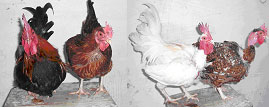 Local germ plasm: Naked Neck and Normal feathered birds. The former is well known for heat tolerance. It is more productive, Disease resistant in comparison to normal feathered local chicken. They lay about 50-60nos. of egg annually. Average live body weight 1-1.5kg.
Local germ plasm: Naked Neck and Normal feathered birds. The former is well known for heat tolerance. It is more productive, Disease resistant in comparison to normal feathered local chicken. They lay about 50-60nos. of egg annually. Average live body weight 1-1.5kg.
- Vanaraja: Dual type bird, specially developed for backyard poultry production by PDP, Hyderabad. They can thrive well under backyard system of management. Their feather colour similar to local indigenous chicken. The taste of their meat and egg is like local chicken and with better quality meat and bigger egg size. Performance is better than the local chicken. They lay about 120-140 nos. of egg annually. Average live body weight at marketing age is 2.5-3.5kg.
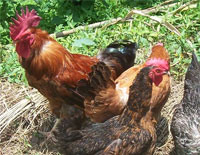
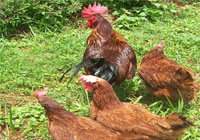 Gramapriya: Egg type bird specially developed for backyard poultry production by PDP, Hyderabad. They can thrive well under backyard system of management. They lay about 130-150 nos. of egg annually. Average live body weight at marketing age is 1.5-2.5kg.
Gramapriya: Egg type bird specially developed for backyard poultry production by PDP, Hyderabad. They can thrive well under backyard system of management. They lay about 130-150 nos. of egg annually. Average live body weight at marketing age is 1.5-2.5kg.
- Japanese quail: Quails are hardy in nature, easy to handle and can adapt in variant environmental condition. Ithas fast growth rate, high rate of laying, requires less housing space and capital investment and almost quite resistant to diseases that generally occurs in chicken.
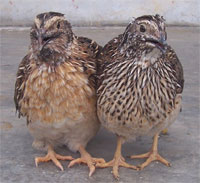
Female attains sexual maturity at the age of 6weeks and produced about 200nos of egg in a year. Size of egg is very small about 10g. Average body weight at the age of marketing age ranges from 180 to120g.
 Turkey: Turkey (Meleagris Gallopavo) is a large gallinaceous bird of the family Meleagridae. They attain sexualmaturity at the age of 200 days. Lay about 100 nos. of egg annually. Average egg weight 70g.Body weight at the age of marketing age ranges from 4.0 to 5.0 Kg.
Turkey: Turkey (Meleagris Gallopavo) is a large gallinaceous bird of the family Meleagridae. They attain sexualmaturity at the age of 200 days. Lay about 100 nos. of egg annually. Average egg weight 70g.Body weight at the age of marketing age ranges from 4.0 to 5.0 Kg.
- e. Emu: Emu (Dromaius Novaehollandiae) is introduced newly in this center. It is mainly reared for meat and skin. The Emu oil has medicinal properity. Mature emu is about 5.5 to 6 feet tall and weigh between 35-50Kg. Female attains sexual maturity at the age of 2 years and lay average 25 nos. of egg in a year. Egg weight range from 450-600g.

Plant Technological Inputs provided to the farmers (improved varieties/seeds/ planting material/breeds)
(2011 – 2012)
| Items | |
| Paddy | Turmeric (rhizomes) |
| Maize | Jalkund - Components |
| Potato | Summer Vegetable Seeds |
| Pea | Goat kids |
| Mustard | Poultry |
| Guava Grafted | Piglets |
| Orange Grafted | Fingerlings |
| Peach | Farm implements |
| Ginger (rhizomes) |
|